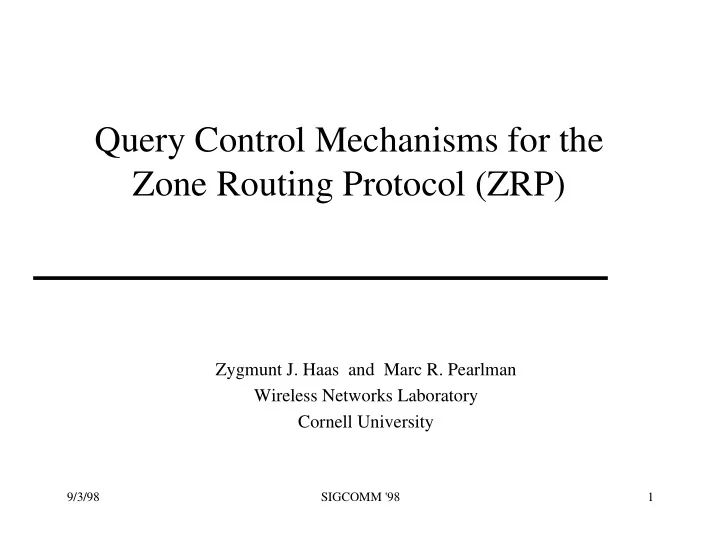

Query Control Mechanisms for the Zone Routing Protocol (ZRP) Zygmunt J. Haas and Marc R. Pearlman Wireless Networks Laboratory Cornell University 9/3/98 SIGCOMM '98 1
Agenda ◆ Introduction - Routing in Mobile Ad-Hoc Networks ◆ The Zone Routing Protocol (ZRP) ◆ Query Control Mechanisms ◆ Simulation Description ◆ Results ◆ Conclusions 9/3/98 SIGCOMM '98 2
Mobile Ad-Hoc Networking ◆ Rapidly deploy a regional (~ 100 m - 100 km) network of mobile hosts, anywhere. ◆ Why? Coordinate Efforts of Distributed Systems – military (battlefield communications) – law enforcement – construction – emergency response 9/3/98 SIGCOMM '98 3
Mobile Ad-Hoc Networking D F B A E C • no infrastructure ! • short range direct communication: A-B , A-C • nodes act as relays: multihop routing: A-D-E-F 9/3/98 SIGCOMM '98 4
Traditional Routing Schemes ◆ Proactive (i.e. distance vector, link state) – maintain up-to-date view of network – extremely high traffic – most routes are not used ◆ Reactive (i.e. route query - response) – acquire routes on demand – high traffic – route query delays 9/3/98 SIGCOMM '98 5
A Hybrid Approach: Introducing the Routing Zone Each node: ◆ Proactively tracks topology within its own routing zone ◆ Reactively acquires routes to nodes beyond routing zone by querying between overlapping zones 9/3/98 SIGCOMM '98 6
Anatomy of a Routing Zone Peripheral Node Routing Zone Radius: ρ (hops) S Neighbor Node 9/3/98 SIGCOMM '98 7
Bordercasting flooding: 30 transmissions bordercasting: 20 transmissions 9/3/98 SIGCOMM '98 8
Route Discovery Example A E S X B C D Y 1) S-X-Y: terminates because Y has no peripheral nodes 2) S-A-B-E-A: terminates because thread returned to A 3) S-A-B-C: successful discovery ! 9/3/98 SIGCOMM '98 9
Benefits of Routing Zones ◆ Proactive: maintain routing zone – routing traffic significantly reduced – routes used more often ◆ Reactive: query only peripheral nodes – fewer query packets – shorter query packets * – reduced delay – routes more robust 9/3/98 SIGCOMM '98 10
Routing Zones Overlap thread enters a zone previously queried by another thread S thread loops back onto a zone which it already queried. Overlapping Zones May Lead to Excess Control Traffic 9/3/98 SIGCOMM '98 11
Encourage Outward Propagation of Queries ◆ Terminate threads that return to a queried node (not strong enough) ◆ Terminate threads that return to a queried zone – threads that loopback on themselves – threads that overlap with other threads ◆ Prevent overlap 9/3/98 SIGCOMM '98 12
Query Control Mechanisms Terminate threads when they appear in previously queried zones – Query Detection (QD) intermediate nodes can detect passing threads w/o QD w/ QD – Early Termination (ET) intermediate nodes can terminate previously detected threads previously detected query 9/3/98 SIGCOMM '98 13
Query Control Mechanisms (cont’d) Special Case: thread loops back on itself – Loopback Termination (LT) (100% effective) use accumulated route to identify loopback condition B query returns to S S’s routing zone A 9/3/98 SIGCOMM '98 14
Query Overlap Prevention: Selective BorderCasting (SBC) full bordercasting selective bordercasting Cover a given set of “outer” peripheral nodes with the fewest “inner” peripheral nodes 9/3/98 SIGCOMM '98 15
Implementing Selective Bordercasting ◆ Extended Routing Zone (at least 2 ρ hops): ◆ For each received query packet . . . – Compute “best” SBC assignment – Send SBC assignments Do the benefits offset the cost? 9/3/98 SIGCOMM '98 16
Simulation Model Static Simulation Parameters d xmit 100m d xmit # nodes 500 1.5 k m Variable Simulation Parameters v 10 - 75 m/s ρ 1-10 hops R query 0.1 - 10 queries/sec 1.5 km 9/3/98 SIGCOMM '98 17
IARP Traffic per m/s 450 Full Bordercasting Selective Bordercasting 400 350 traffic (ID fields/sec) 300 250 200 150 100 50 0 1 2 3 4 5 6 7 8 9 10 routing zone radius ( ρ ) 9/3/98 SIGCOMM '98 18
IERP Traffic per Route Discovery 100 QD1−LT−ET 90 QD2−LT−ET SBC−QD1−LT−ET None 80 traffic (ID fields/sec · 1000) 70 60 50 40 30 20 10 0 1 2 3 4 5 6 7 8 9 10 routing zone radius ( ρ ) 9/3/98 SIGCOMM '98 19
Total ZRP Control Traffic v = 10 [m/sec] R query = 0.1 [query/sec] 4 QD1−LT−ET QD2−LT−ET 3.5 SBC−QD1−LT−ET 3 traffic (ID fields/sec · 1000) 2.5 2 1.5 1 0.5 0 1 2 3 4 5 6 7 8 9 10 routing zone radius ( ρ ) 9/3/98 SIGCOMM '98 20
Optimal ZRP Configuration 8 QD1−LT−ET QD2−LT−ET SBC−QD1−LT−ET 7 6 Routing Zone Radius ( ρ ) 5 4 3 2 1 1 2 10 10 Call to Mobility Ratio (CMR) 9/3/98 SIGCOMM '98 21
Conclusions ◆ ZRP can perform worse than flooding without proper query control mechanisms. ◆ QD, ET and LT provide significant improvements compared with purely reactive ( ρ = 1) and purely proactive schemes ( ρ → ∞ ). ◆ Optimal ZRP radius is an increasing function of the Call-to-Mobility Ratio (CMR). ◆ Use of SBC depends on delay and computational complexity considerations. 9/3/98 SIGCOMM '98 22
Recommend
More recommend